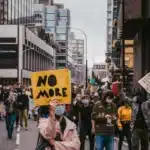Christian Social Justice Activism
Table of Contents
James Roberson III scaled a ladder in downtown Brooklyn on June 2, 2020, with a megaphone in his hand, as protestors converged below him. He had expected a few hundred; thousands showed up.
One week earlier, Roberson—a married father of three and pastor of Bridge Church NYC—had watched the infamous video of George Floyd dying. He couldn’t believe the “total disregard for humanity.”
As a Christian, a pastor, and a Black man in America, he felt compelled to say something. Beyond the crowd in New York, his remarks have been viewed more than 19,000 times on Facebook Live.
“Anyone whose heart doesn’t break when you see that video, don’t ask me to explain why my heart breaks,” Roberson says, crying. “If your heart doesn’t break when you see something like that, please … don’t make me explain my rage.”
Roberson had spent decades explaining—particularly to his white evangelical friends—why the killings of Black men and women at the hands of law enforcement officers or white vigilantes were so painful and so personal.
He and a group of fellow local pastors and believers soon grew their grief and activism into a movement: Pray March Act (PMA). Their marches in Brooklyn, Long Island, and Minneapolis drew media attention in the aftermath of George Floyd’s death.
Their language was not filled with violent or hateful rhetoric but aimed at advocating for police and other enforcers of the law to regard and treat Black citizens with the same dignity and respect as their white counterparts.
A Movement Rooted in Faith
“We wanted the protest to be deeply Christian,” Roberson said. “The cops are made in the image of God, just like George Floyd was made in the image of God. But we are against the practice of civic authorities seeing Black people as lesser than. And we need to speak truth to power.”
Three years in, they still pray, and they still march. But they realized the “act” part of the mission couldn’t be centered on chasing headlines. Their time would be better spent advocating for racial justice and equality on a local level.
Today, PMA’s small, core group of NYC churches holds online and in-person events that draw believers from across the city. Their key goals are to educate the public, pray for racial justice, and work to end racism.
This year, PMA held a large rally in Harlem on Martin Luther King Jr. Day. Since then, PMA leaders have been studying the city’s proposed 2024 budget and advocating for projects that prioritize racial justice. On June 16, the group will screen a Juneteenth documentary in Brooklyn. Juneteenth: Faith & Freedom was produced by one of PMA’s founding members and director of communications, Rasool Berry.
Addressing Racial Disparities in New York City
Last year, after gathering input from public school teachers, community activists, and government leaders, PMA identified three areas with some of the most glaring racial disparities in New York City: housing, education, and criminal justice. And like the city’s aging, labyrinthine subway system, everything is interconnected.
Safe, affordable housing is out of reach for huge swaths of the population. As a result, hundreds of thousands of New Yorkers live in public housing. And New York City is consistently ranked—by its own public advocate—as the worst landlord in the five boroughs.
Housing, in turn, impacts the quality of schools in the area.
“Communities of wealth will always have an advantage towards education,” Roberson said. “And communities of poverty will always have a disadvantage. If the real estate’s a certain price, the education’s going to be a certain level.”
Wherever they moved, the Robersons got involved with their local public school’s Parent-Teacher Association (PTA). The PTA in Park Slope (one of the wealthiest, whitest neighborhoods in Brooklyn) generated over a million dollars, while the PTA in Flatbush (a majority-Black neighborhood) had $40. These two Brooklyn communities are on opposite sides of Prospect Park, just a mile apart.
The Brokenness of Racial Disparities
George Sarkissian, an elder at Uptown Community Church in northern Manhattan, serves as PMA’s executive director. He has a unique vantage point as a city employee at NYC’s Department of Housing Preservation and Development. As chief of staff and deputy commissioner for external affairs, Sarkissian has an up-close view of the nation’s biggest city.
Sarkissian points to communities like Brownsville, Brooklyn, where 66% of the population is Black and the median household income is $40,000. Just 28% of fourth graders in Brownsville are performing at grade level in language arts. Fewer than one in five are proficient in math.
Across the East River in Lower Manhattan’s Financial District, 66% of the population is white, and the median household income is $151,000. About 83% of fourth graders are performing at grade level in English. Four in five are proficient in math.
“There are just huge disparities,” Sarkissian said. “There’s a brokenness that’s really clear.’”
Just as a family’s ZIP code tends to determine the quality of education their children receive, success in school predicts the likelihood of a student going to prison later—and thus, the cycles of incarceration and poverty go around and around.
“There are plenty of neighborhoods that are doing just fine in New York City,” Sarkissian said. “I’ve always been interested in the neighborhoods that are struggling. … Those are the neighborhoods that the Lord has given me a heart to serve.”
Harnessing the Power of Public Policy
Sarkissian invokes the Old Testament as inspiration for making the city a better place to live, pointing to Jeremiah 29—where “God’s people are in Babylon, and God instructs them to seek the peace and prosperity of the city,” Sarkissian said.
He believes public policy is a tool the church can use to help cities thrive today. “The church has worked with government in the past to essentially accomplish kingdom goals,” Sarkissian said, “and there’s no reason the church shouldn’t do it now.”
Cidra Sebastien is another PMA leader who believes prayer and public policy can work in tandem. Sebastien has been a New Yorker since the early 80s and is part of Renaissance Church NYC in Harlem. She serves as PMA’s director of organizing and leads the education group.
Sebastien wants to see NYC’s 1 million public school students have equal access to a great education. One of her passions is advocating for quality mental health care, particularly after three disruptive pandemic years that disproportionately affected Black and brown families.
“Students are bringing what they’re experiencing at home to their neighborhood school,” Sebastien said. “And yet, there are not enough trained, caring, culturally competent guidance counselors at schools.”
It’s not because great guidance counselors aren’t out there, Sebastien said. “It’s because the city has decided that’s not where they want to put their priority.” The ratio of guidance counselors to NYC public school students is 1:272. Even the very best counselor, Sebastien said, can’t effectively serve that many students at once.
“It’s impossible, right? And so that’s something the members of PMA want to see us address,” Sebastien said. And that’s where one of PMA’s core tenets comes in: “We pray … because the task is bigger than us.”
“The only way we stay hopeful is because we’re the church,” Sarkissian said. “There’s a kingdom effort that we’re participating in, and that’s the big Jesus project to renew all things.”
With kingdom goals in mind, PMA members recently stood before government leaders to advocate for racial justice in NYC. They shared their vision at the city council’s budget hearing on May 24.
“It was the first time we publicly advocated for policy changes,” Sarkissian said, “addressing legislators who are negotiating the NYC budget, and identifying ourselves as members of PMA.”
Building a Just and Loving Community
Three years after George Floyd’s death, Roberson prays more evangelical believers will incorporate racial justice into their theology. “You’ll find churches where their theology is about reaching people and seeing them go to heaven,” Roberson said. “But what about the conditions they’re in now?”
In the parable of the Good Samaritan, a man is attacked on the road to Jericho and left for dead. What if, Roberson asks, believers took a closer look at the road?
“We take care of the guy. We help him out, but we don’t really evaluate the road to Jericho,” Roberson said. “We don’t really ask, ‘Why does that keep happening?’ And that’s what justice is about. Justice looks at the systems that are causing the poverty. And I believe the racial tension in our country is deeply spiritual.”
This Juneteenth, he sees an opportunity for white Christians to think about the privileges they enjoy and the ways their own families, churches, and communities contribute to inequality. He hopes more believers will examine America’s “road to Jericho.” That’s how efforts like Pray March Act can become sustainable movements; that’s how the church can become a “city on a hill.”
“I think what comes before evangelism is God’s glory,” Roberson said. “You have to be able to glorify God by loving your neighbor. “Certainly, I want my neighbor to experience God personally, but my first job is to have them experience God through my love and character. And the way I think we love the city is through the way we respond to the brokenness.”
Kristy Etheridge is a freelance writer and editor and a former TV news journalist. Originally from southeastern Pennsylvania, Kristy lives in Brooklyn, New York, with her husband, Dustin, and two young children.

 Next Post
Next Post
